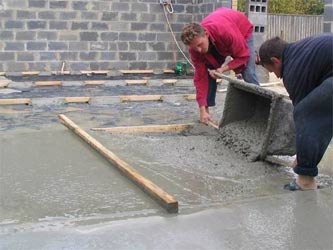Industrial floors: technology for concrete and bulk floors at enterprises
Floors of industrial buildings are used in various industries. They are found in workshops, warehouses, industrial enterprises, shopping malls, etc. That is, in places where large sites are required with a reliable foundation that can withstand steady loads, temperature extremes and even exposure to aggressive environments. The production technology of industrial floors is currently at a fairly high level, so requirements for aesthetics, hygiene and ergonomics are imposed on floors of this type.
Types of industrial floors
Depending on the purpose, industrial fields are divided into:
- floors for terminals, warehouses, material and technical premises and production sites;
- floors for production sites with high levels of humidity;
- floors for rooms with increased steady load;
- floors of public premises (medical buildings, child care facilities, canteens, etc.);
- floors of industrial freezers and refrigerators;
- floors in deactivated buildings and sanitary checkpoints in the nuclear industry;
- antistatic, fire and explosion-proof floors;
- polyurethane floors for sports fields and centers.
Important! The production technology of industrial floors, which are based on a concrete component, is not recommended to be used in its pure form, due to their excessive hygroscopicity, low resistance to abrasion and the lack of the possibility of dust removal from the surface.
Industrial concrete floors
The device of industrial concrete floors should take into account the characteristics of all elements of the room: old floors, walls, ceilings and of course equipment that will be placed on the new floor. Concrete floors, as it were, were not widely used, naturally they have their drawbacks and advantages, which are definitely more.
This type of flooring historically appeared much earlier than other bulk coatings and gained popularity due to the fact that it solved many problems that were relevant at that time: resistance to various chemical and mechanical influences, decent strength and ease of cleaning. In a word, the concrete floor has become an excellent substitute for wooden floors, which used to lie in all workshops, warehouses and factories.
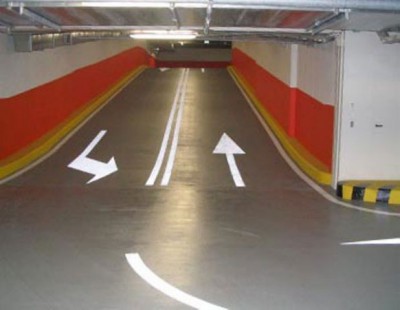
At the moment, the concrete floor can also act as an independent floor covering, under conditions if the requirements for strength and resistance are not particularly high. But if the requirements increase, then it plays the role of only the basis and no more. In modern conditionsIndustrial concrete floors are often criticized because of their insufficient resistance to strong chemical and mechanical influences, but this problem is resolvable.
There are two methods to solve this problem:
- selection of high quality concrete;
- strengthening of the upper layer, the so-called topping.
The first method gives the overall concrete mass higher strength properties, but adhesion with subsequent layers of flooring is markedly reduced, which sometimes leads to delamination of the floor. To avoid such situations, primers with a reduced coefficient of viscosity of the material should be used. As for topping, this is the process of strengthening the surface of concrete with pre-prepared dry mixes.That is, a hardening layer is applied consisting of quartz, cement and other special additives. Work is performed using a concrete-finishing machine.
Interesting! The industrial concrete floor covered with special topping lasts several times longer: the impact resistance of such a floor is two times higher than that of a regular one, and the wear resistance is up to eight times.
Industrial polymer floors
This is a fairly large class of building flooring. Classification of polymer floors by composition:
- Epoxy floors - have a high degree of rigidity, do not react with most of the chemical elements, and therefore they have high chemical resistance, but are very sensitive to temperature extremes.
- Epoxy-urethane floors - have a high degree of chemical resistance, which is perfectly combined with great elasticity.
- Polyurethane floors - they are resistant to mechanical, chemical and thermal influences.
- Methyl methacrylate floors - this type of polymer floor has minimal chemical and mechanical resistance, but is quite resistant to low temperatures.
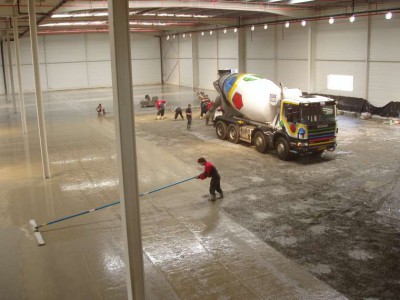
Features of the device of the bulk base
Polymer and concrete floors in industrial buildings require special laying technology. Filling such floors consists of several stages.
Stage 1: Foundation Preparation
Before starting the pouring of industrial floors, the master must check the suitability of the concrete base for holes, potholes, debris, etc. Also, the foundation should be checked for level, using a building measure. If any defects are found, they should be eliminated immediately, otherwise more filling material will be consumed than was planned. When the base is cleaned and leveled, according to the technology of bulk floors, it should be impregnated with special substances. The primer layer is applied with a roller and brush evenly over the surface. Then the primer should dry from 12 to 24 hours.
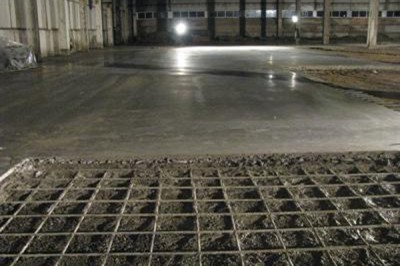
Stage 2: Material Application
Before applying the floor mixture must be prepared in accordance with all technological excerpts. By and large, there is nothing complicated in the construction of bulk industrial floors. The most important point is the location of each portion of the floor mixture next to another. This condition must be met to see what the thickness of the future layer should be. After applying the mixture, it is recommended to pass with a needle roller or a stiff brush along its surface in order to break and remove the existing air bubbles.
The most important requirement for the implementation of the process of pouring floors is the total control of humidity in the room. Specialists regulate humidity for several days before starting work. The maximum humidity should be 60%, and the humidity of the base for industrial floors - 5%. The quality and service life of the future bulk industrial floor depends on this.
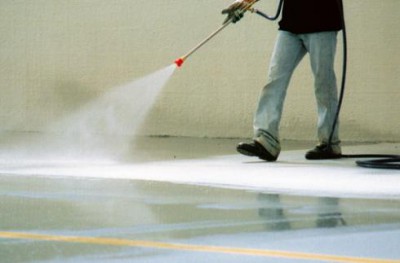
It is also no less responsible to relate to maintaining the temperature in the room, it should vary within from +5 to +25 ° C. So that the mixture does not spread too quickly and does not seize very quickly. After the industrial floor mixture has been poured onto a concrete base, it should stand for at least a month without mechanical and chemical influences.
If you have met all the conditions and requirements when performing this simple process, then you can walk on this floor in a day, and the installation of any equipment or furniture can be done in 10 days, but this should be done with relatively small overall dimensions of the installed objects.

